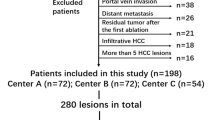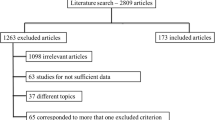Abstract
Introduction
The imaging features of unresectable hepatic malignancies in patients who underwent radiofrequency ablation (RFA) in combination with lyso-thermosensitive liposomal doxorubicin (LTLD) were determined.
Materials and Methods
A phase I dose escalation study combining RFA with LTLD was performed with peri- and post- procedural CT and MRI. Imaging features were analyzed and measured in terms of ablative zone size and surrounding penumbra size. The dynamic imaging appearance was described qualitatively immediately following the procedure and at 1-month follow-up. The control group receiving liver RFA without LTLD was compared to the study group in terms of imaging features and post-ablative zone size dynamics at follow-up.
Results
Post-treatment scans of hepatic lesions treated with RFA and LTLD have distinctive imaging characteristics when compared to those treated with RFA alone. The addition of LTLD resulted in a regular or smooth enhancing rim on T1W MRI which often correlated with increased attenuation on CT. The LTLD-treated ablation zones were stable or enlarged at follow-up four weeks later in 69 % of study subjects as opposed to conventional RFA where the ablation zone underwent involution compared to imaging acquired immediately after the procedure.
Conclusion
The imaging features following RFA with LTLD were different from those after standard RFA and can mimic residual or recurrent tumor. Knowledge of the subtle findings between the two groups can help avoid misinterpretation and proper identification of treatment failure in this setting. Increased size of the LTLD-treated ablation zone after RFA suggests the ongoing drug-induced biological effects.






Similar content being viewed by others
References
Okuwaki Y, Nakazawa T, Kokubu S, et al. Repeat radiofrequency ablation provides survival benefit in patients with intrahepatic distant recurrence of hepatocellular carcinoma. Am J Gastroenterol. 2009;104:2747–53. doi:10.1038/ajg.2009.414.
Aloia TA, Vauthey J-N, Loyer EM, et al. Solitary colorectal liver metastasis: resection determines outcome. Arch Surg. 2006;141:460–6. doi:10.1001/archsurg.141.5.460 discussion 466–467.
Solbiati L, Livraghi T, Goldberg SN, et al. Percutaneous radio-frequency ablation of hepatic metastases from colorectal cancer: long-term results in 117 patients. Radiology. 2001;221:159–66.
Mulier S, Ni Y, Jamart J, et al. Local recurrence after hepatic radiofrequency coagulation: multivariate meta-analysis and review of contributing factors. Ann Surg. 2005;242:158–71.
Siperstein AE, Berber E, Ballem N, Parikh RT. Survival after radiofrequency ablation of colorectal liver metastases: 10-year experience. Ann Surg. 2007;246:559–65. doi:10.1097/SLA.0b013e318155a7b6 discussion 565–567.
Berber E, Pelley R, Siperstein AE. Predictors of survival after radiofrequency thermal ablation of colorectal cancer metastases to the liver: a prospective study. J Clin Oncol. 2005;23:1358–64. doi:10.1200/JCO.2005.12.039.
Abu-Hilal M, Primrose JN, Casaril A, et al. Surgical resection versus radiofrequency ablation in the treatment of small unifocal hepatocellular carcinoma. J Gastrointest Surg. 2008;12:1521–6. doi:10.1007/s11605-008-0553-4.
Hong SN, Lee S-Y, Choi MS, et al. Comparing the outcomes of radiofrequency ablation and surgery in patients with a single small hepatocellular carcinoma and well-preserved hepatic function. J Clin Gastroenterol. 2005;39:247–52.
Yun WK, Choi MS, Choi D, et al. Superior long-term outcomes after surgery in child-pugh class a patients with single small hepatocellular carcinoma compared to radiofrequency ablation. Hepatol Int. 2010;5:722–9. doi:10.1007/s12072-010-9237-8.
Petrowsky H, Busuttil RW. Resection or ablation of small hepatocellular carcinoma: what is the better treatment? J Hepatol. 2008;49:502–4. doi:10.1016/j.jhep.2008.07.018.
Gasselhuber A, Dreher MR, Negussie A, et al. Mathematical spatio-temporal model of drug delivery from low temperature sensitive liposomes during radiofrequency tumour ablation. Int J Hyperthermia. 2010;26:499–513. doi:10.3109/02656731003623590.
Wood BJ, Poon RT, Locklin JK, et al. Phase I study of heat-deployed liposomal doxorubicin during radiofrequency ablation for hepatic malignancies. J Vasc Interv Radiol. 2012;23(248–255):e7. doi:10.1016/j.jvir.2011.10.018.
Thomas MB, Jaffe D, Choti MM, et al. Hepatocellular carcinoma: consensus recommendations of the National Cancer Institute Clinical Trials Planning Meeting. J Clin Oncol. 2010;28:3994–4005. doi:10.1200/JCO.2010.28.7805.
Hong CW, Libutti SK, Wood BJ. Liposomal doxorubicin plus radiofrequency ablation for complete necrosis of a hepatocellular carcinoma. Curr Oncol. 2013;20:e274–7. doi:10.3747/co.20.1266.
Goldberg SN, Grassi CJ, Cardella JF, et al. Image-guided tumor ablation: standardization of terminology and reporting criteria. J Vasc Interv Radiol. 2009;20:S377–90. doi:10.1016/j.jvir.2009.04.011.
Nghiem HV, Francis IR, Fontana R, et al. Computed tomography appearances of hypervascular hepatic tumors after percutaneous radiofrequency ablation therapy. Curr Probl Diagn Radiol. 2002;31:105–11.
Schima W, Ba-Ssalamah A, Kurtaran A, et al. Post-treatment imaging of liver tumours. Cancer Imaging. 2007;7:S28–36. doi:10.1102/1470-7330.2007.9047.
Vossen JA, Buijs M, Kamel IR. Assessment of tumor response on MR imaging after locoregional therapy. Tech Vasc Interv Radiol. 2006;9:125–32. doi:10.1053/j.tvir.2007.02.004.
Solbiati L, Goldberg SN, Ierace T, et al. Hepatic metastases: percutaneous radio-frequency ablation with cooled-tip electrodes. Radiology. 1997;205:367–73.
Goldberg SN, Gazelle GS, Mueller PR. Thermal ablation therapy for focal malignancy: a unified approach to underlying principles, techniques, and diagnostic imaging guidance. AJR Am J Roentgenol. 2000;174:323–31. doi:10.2214/ajr.174.2.1740323.
Gazelle GS, Goldberg SN, Solbiati L, Livraghi T. Tumor ablation with radio-frequency energy. Radiology. 2000;217:633–46.
Catalano O, Esposito M, Nunziata A, Siani A. Multiphase helical CT findings after percutaneous ablation procedures for hepatocellular carcinoma. Abdom Imaging. 2000;25:607–14.
Lim HK, Choi D, Lee WJ, et al. Hepatocellular carcinoma treated with percutaneous radio-frequency ablation: evaluation with follow-up multiphase helical CT. Radiology. 2001;221:447–54.
Acknowledgments
This work was supported by the Center for Interventional Oncology, the National Cancer Institute, and the Intramural Research Program of the National Institutes of Health (NIH). The content of this publication does not necessarily reflect the views or policies of the Department of Health and Human Services, nor does mention of trade names, commercial products, or organizations imply endorsement by the U.S. Government. This research was made possible through the NIH Medical Research Scholars Program, a public–private partnership supported jointly by the NIH and generous contributions to the Foundation for the NIH from Pfizer Inc, The Leona M. and Harry B. Helmsley Charitable Trust, and the Howard Hughes Medical Institute, as well as other private donors. For a complete list, please visit the Foundation website at http://www.fnih.org/work/programs-development/medical-research-scholars-program).
Author information
Authors and Affiliations
Corresponding author
Ethics declarations
Conflict of Interest
National Institutes of Health and Celsion Corp have a cooperative research and development agreement. Dr. Riccardo Lencioni is a consultant for Celsion Corp.
Ethical Approval
All procedures performed in studies involving human participants were in accordance with the ethical standards of the institutional and/or national research committee and with the 1964 Helsinki declaration and its later amendments or comparable ethical standards.
Informed Consent
Informed consent was obtained from all individual participants included in the study.
Rights and permissions
About this article
Cite this article
Hong, C.W., Chow, L., Turkbey, E.B. et al. Imaging Features of Radiofrequency Ablation with Heat-Deployed Liposomal Doxorubicin in Hepatic Tumors. Cardiovasc Intervent Radiol 39, 409–416 (2016). https://doi.org/10.1007/s00270-015-1186-0
Received:
Accepted:
Published:
Issue Date:
DOI: https://doi.org/10.1007/s00270-015-1186-0




